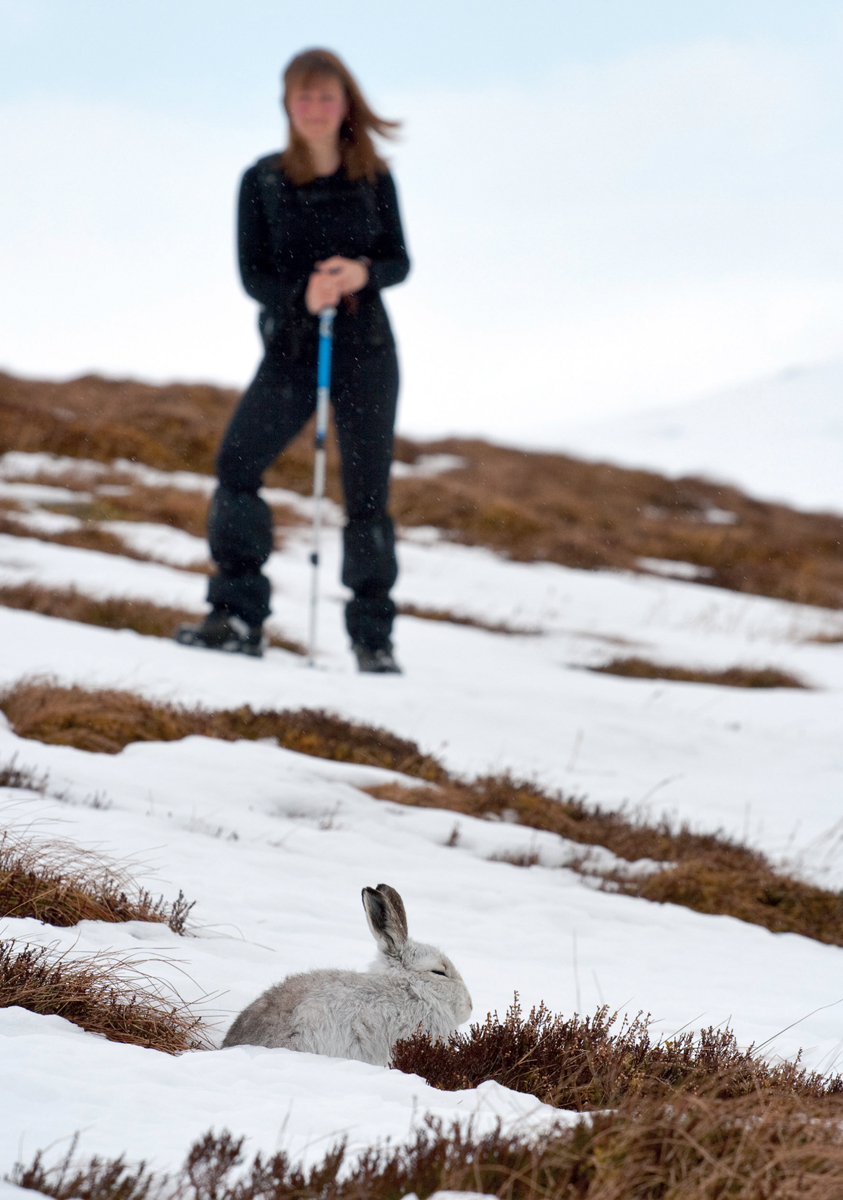
A walker catches a glimpse of a Mountain Hare in the Cairngorms National Park, Scotland.

A walker catches a glimpse of a Mountain Hare in the Cairngorms National Park, Scotland.
How to See Hares
For most people, getting a good view of any wild mammal is a rare and thrilling experience. Hares are elegant and beautiful, but also timid, secretive and elusive so trying to get a good view is worth the effort. A glimpse into the private life of the hare will open up a new and exciting world. If you aren’t lucky enough to spot hares, the next best thing is discovering clear evidence of their existence. So keep your eyes down when you are in hare country – you might see a lovely soft form or a clear footprint.
Where to watch hares
If you are keen to see hares, it’s best to head to a flat open area, preferably an arable field if you’re looking for Brown Hares. For Mountain Hares in Scotland, your best chance will be in heather moorland, whereas for Irish Hares, any kind of agricultural land is a good option. Stick to roads or public footpaths, or seek permission from the landowner. European Rabbits and hares don’t usually occupy the same areas, so if you see Rabbits or find Rabbit burrows in dry, sandy soil, you are unlikely to find hares nearby. Most farmers and other landowners know when they have hares on their land, so it’s always worth asking them. And ask at nature reserves too – if hares are there, the reserve staff will know, and they may be able to tell you the best places to watch hares without disturbing them.
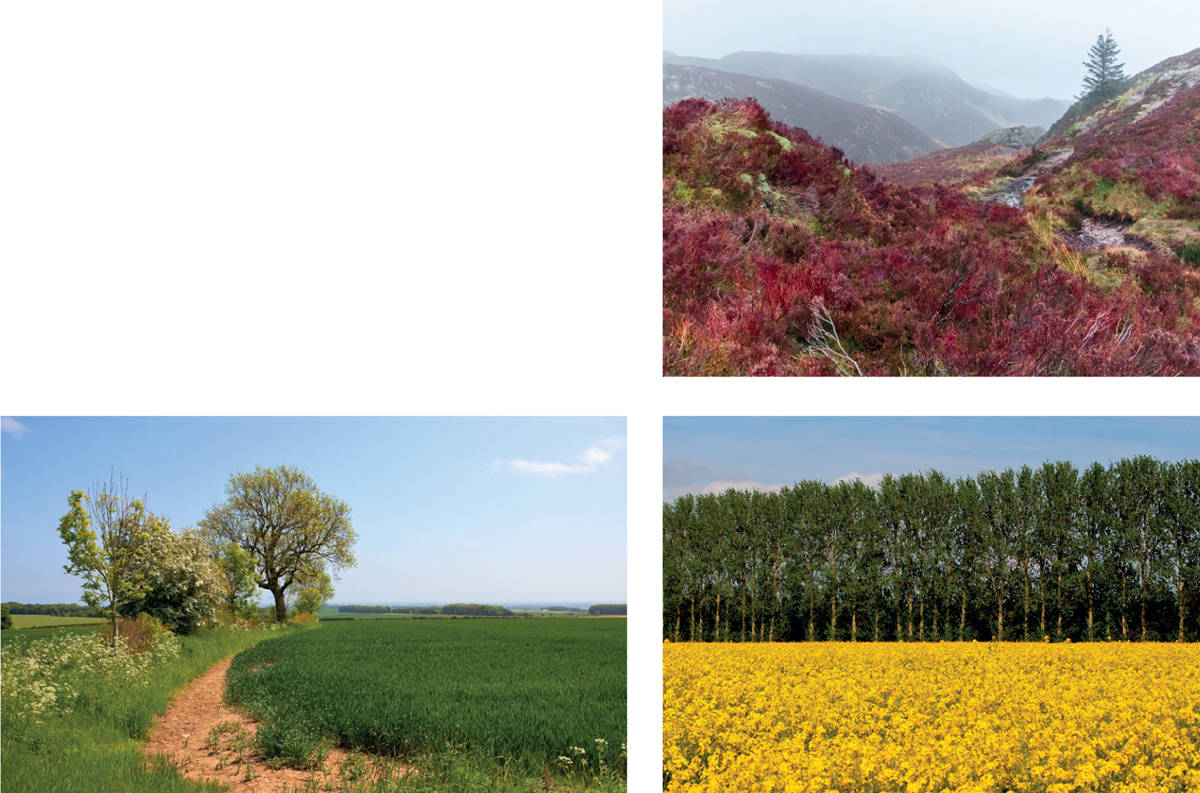
Heather moorland (top right) is the best place to look for Scottish Mountain Hares. Brown Hares and Irish Hares can be seen in arable fields (bottom left and right) and in grassland.
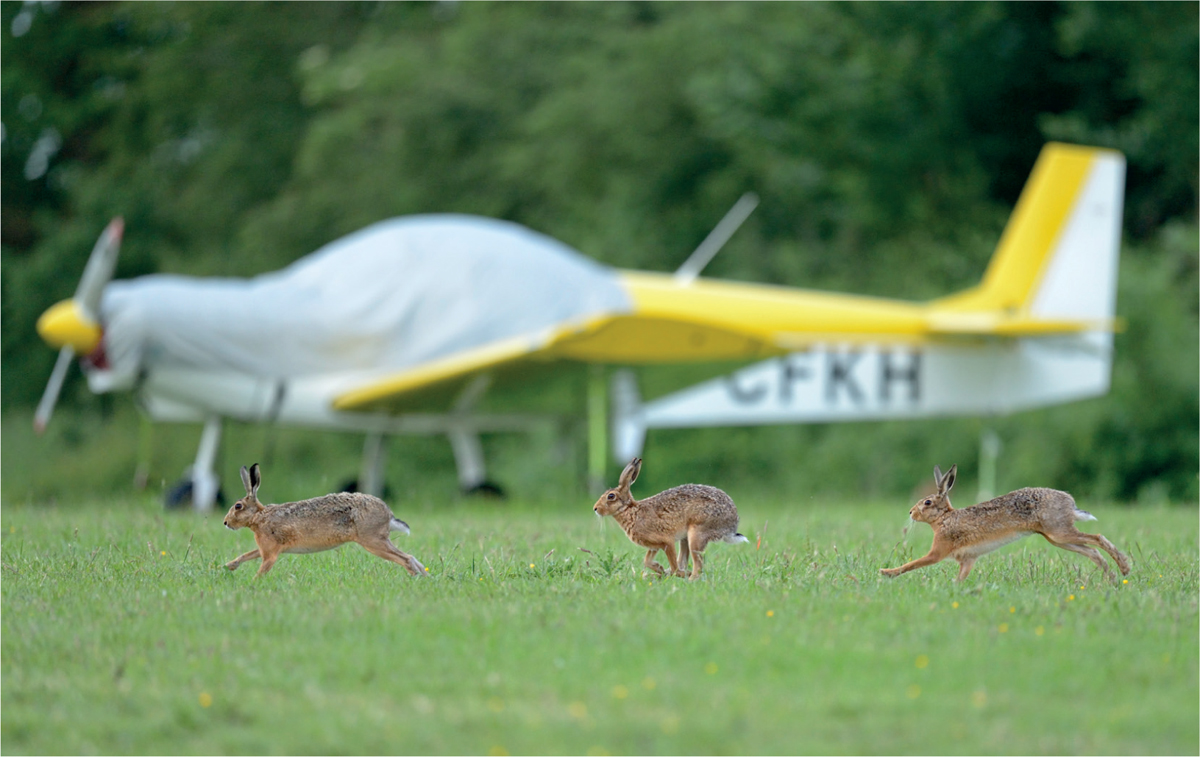
You might be surprised to learn that airports are often good places to see hares.
Hares are challenging to find, so allow plenty of time. In bright light, try scanning for hares in their forms by using binoculars. Hares may, at first, look like cow pats or molehills, but with practice you will be able to identify them. By walking around in the daytime, you may be able to flush an occasional hare from its form.
Once you have identified a likely site, try visiting at dusk or dawn in spring or early summer. It’s best to leave dogs at home. During the breeding season, dusk is the time to see mother hares suckling their leverets. If you can, find a high, but comfortable, vantage point – a bird hide, a bench, a good spot on a public footpath, or a car parked by the side of the road. Keep still and quiet, be patient, and keep scanning with and without your binoculars. You might just see something amazing.
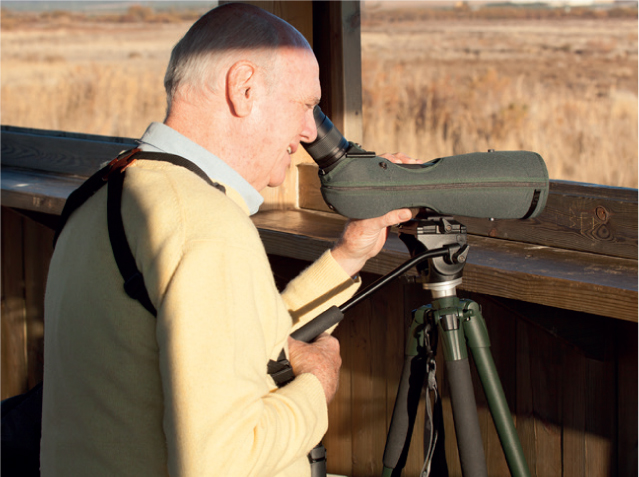
A bird hide can help you get a good view of hares.
With permission from the landowner, you could also try lamping at night. First, make sure that people in nearby houses know what you are doing, or they may be alarmed or worry that you are poaching. You need a powerful torch – move it slowly and you may see hares feeding in the beam of light. You are likely to see many more than you would during the day, as hares are likely to be feeding at night.

If you see a hare during the day, you are likely to see more at the same place at night.

An arable field before the crop gets too high is an attractive feeding spot for Brown Hares and therefore is also a good place to try and see them.
March to June is perhaps the best time of year to see hares – when the nights are short, so they are active in daylight, but the vegetation is not yet too high. If you are lucky enough to find a good place to watch hares, they will probably be there all year round. You might be able to see for yourself the annual cycle of mating, boxing, breeding and growing.
Tracks and signs
If you don’t see hares, hares then finding proof that they have been around, in the form of field signs, is the next best thing. Brown Hares leave faint trails (paths) 10–20cm (4–7¾in) wide, but if you find one it is hard to be sure it is used by hares, and not Badgers, Foxes, deer or sheep. Tracks made by Mountain Hares are more obvious, and tend to go up and down hills, rather than along the contour; they are maintained by hares biting the vegetation.
Hares may leave footprints: impressions of the hind feet (6–15cm/2⅓–6in long, 3.5cm/1⅓in broad, with four toe prints visible) in front of those of the front feet (4–5cm/1½–2in long, 3cm/1⅛in broad, five toes, though the inner toe or thumb may not be visible in prints). The hind feet are often side by side; the front feet are one behind the other. When hares are moving at speed, the hind feet pass the front feet in each stride. In good prints, the claws are visible. The prints of Scottish Mountain Hares and Irish Hares are very similar to, though slightly smaller than those of Brown Hares.
Rabbits’ footprints are still smaller – the hind footprint is up to 4cm (1½in) long and 2.5cm (1in) broad. One way to tell them apart is by placing a matchbox (c. 5 x 3.5cm/2 x 1⅓in) over the hind footprint. If the matchbox is about the same width as the print, it is a hare’s; if the print is about two-thirds the width of the matchbox, it is a Rabbit’s. In hares, the hind feet are much longer than the front feet; in Rabbits, the hind feet are only about twice the length of the front feet, but often in prints the whole hind footprint is not visible. With luck, you might find prints made by a hare sitting on its haunches, and the full length of the hind feet will be visible; otherwise the whole foot shows only on very soft ground. The soles of hare and Rabbit feet are completely covered in hair, so their prints are unlike those of a dog or cat, in which clear indentations made by the pads of the feet can often be seen.
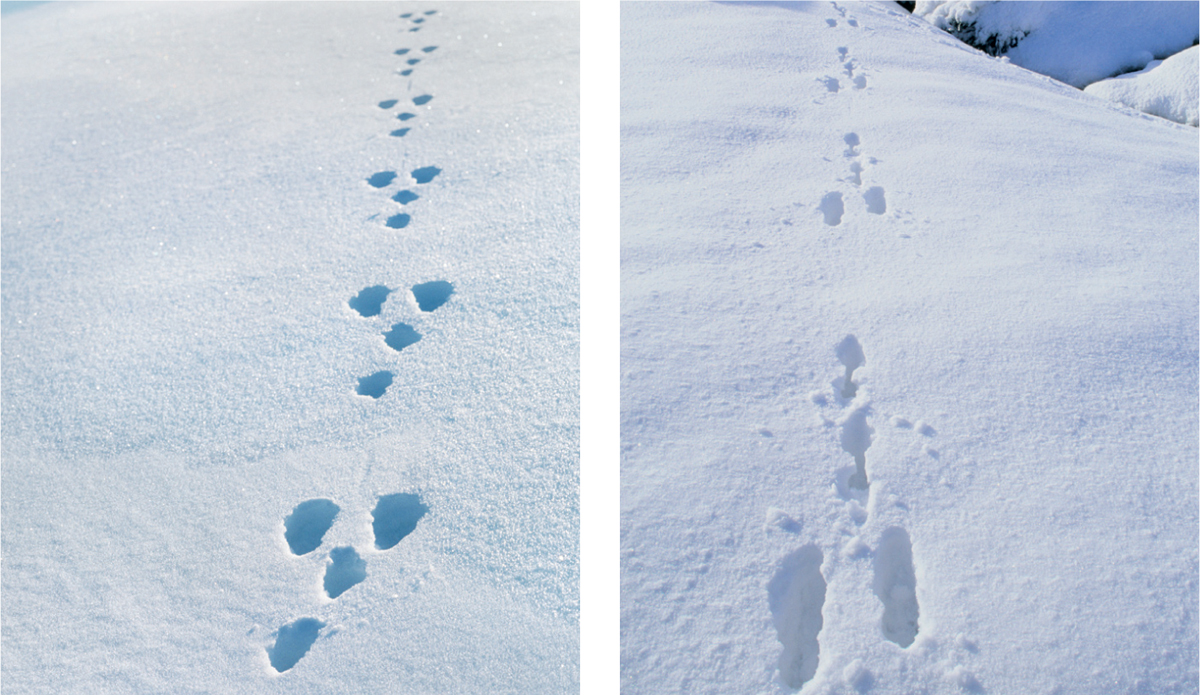
Footprints in the snow are hard to identify, especially once the sun starts to melt them. These Mountain Hare footprints (right), photographed in the Peak District, UK, look very similar to Brown Hare footprints. It’s unclear which species of hare made the footprints on the left.

A snug form made by a hare in frosty grass.
If you are lucky, you might find a hare’s form in vegetation or a ploughed field. Forms of Brown Hares may be dug up to 10cm (4in) into the ground, and are 10–20cm (4–7¾in) wide and about 25cm (9¾in) long. The deepest part of the form is the resting place for the hare’s backside, and is often against a clump of grass, a stone or something else that provides shelter. Scottish Mountain Hares make well-defined forms, often in heather or rushes, located to ensure a good view.
Identification of droppings can be tricky: those of hares are 1.5–2cm (⅔–¾in) in diameter, slightly flattened brown or yellow-brown spheres, made of coarse plant fragments. Often they are found individually, though sometimes 10 or more are found in one place. The droppings of Rabbits are usually found in bigger piles, sometimes on raised hummocks, but they are smaller, about 1cm (⅓in) in diameter.
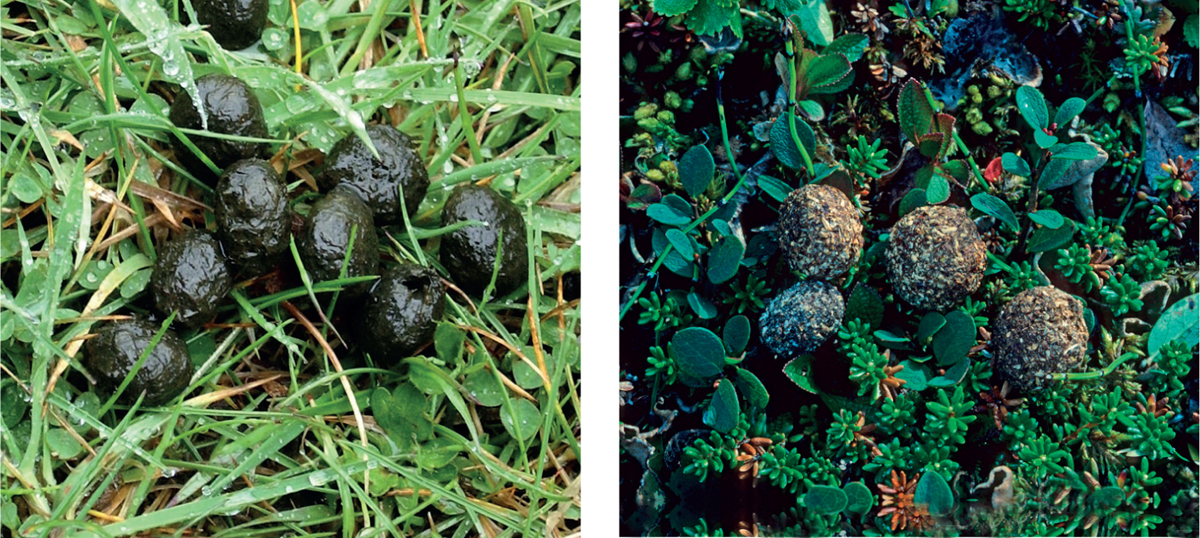
Rabbit droppings (left) and Mountain Hare droppings (right) can be very hard to tell apart.

A hare running off, showing the clear markings on its ears and tail.